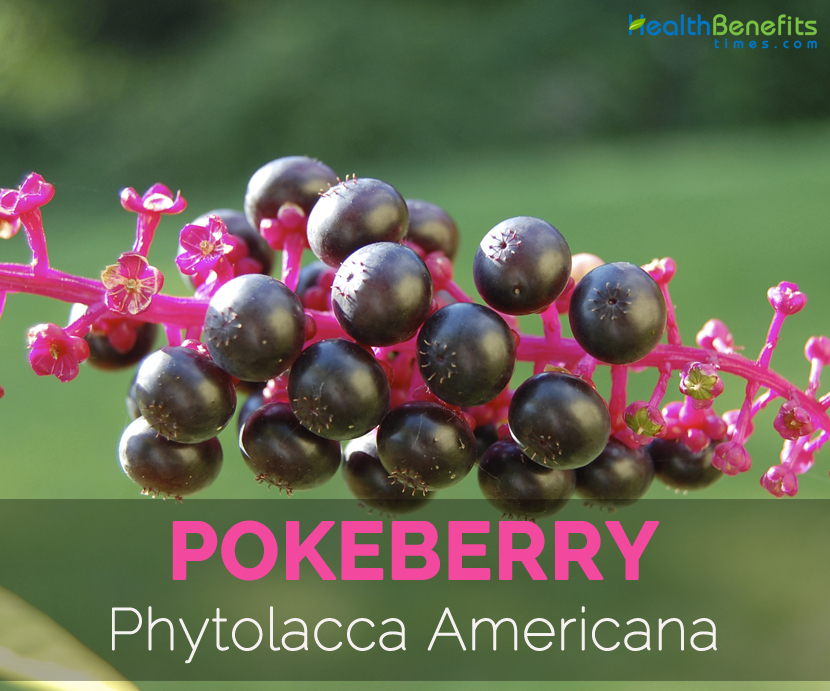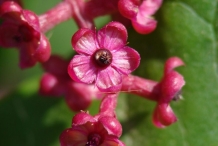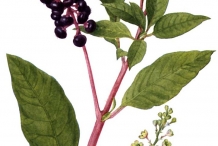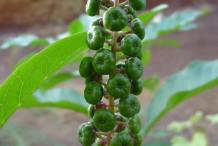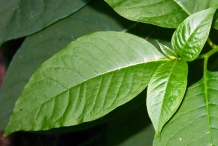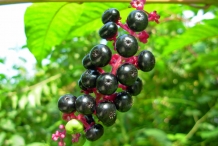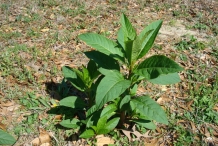| Pokeberry Quick Facts |
| Name: |
Pokeberry |
| Scientific Name: |
Phytolacca americana |
| Origin |
Eastern United States |
| Colors |
Purple-black |
| Shapes |
Rounded, slight flattened, Width: ¼- ½ inch; Diameter: 0.25 inch (0.6 cm) |
| Calories |
37 Kcal./cup |
| Major nutrients |
Vitamin C (241.78%)
Vitamin A (99.43%)
Vitamin B2 (40.62%)
Iron (34.00%)
Manganese (29.09%)
|
| Health benefits |
Healthy skin, Reduce inflammation, Prevent anemia, Healthy pregnancy, Bone health |
| More facts about Pokeberry |
Phytolacca Americana, American nightshade, cancerroot, cancer jalap, coakum, chongras, crowberry, pokeberry, inkberry, garget, poke, pigeonberry, scoke, red ink plant, is an herbaceous plant with berry like fruit, native to Eastern United States where it prefers damp soils. Bunches of small, glossy, dark purple fruit develop on the stems which mature during August – November. Pokeberry should not be consumed raw as it is highly toxic. The cooked berries are safe to make pies. The juice extracted from the Pokeberries is used to enhance the color of wines.
Plant
It is an herbaceous perennial plant that can grow to 2-12 feet in height. The fleshy taproot is large, thick and coarse with 4-6 inches as a diameter. The stems are stout and erect which varies in color from green, red, pink or purple up to 3-7 feet high. The leaves are alternate, lanceolate to nearly ovate; 3½-20 inches long and 1½-5 inches wide. The flowers are symmetrical, green or white-pink which is about ¼-½-inch wide. The fruit is rounded, slightly flattened, purple-black; ¼- ½ inch wide and 0.25 inch (0.6 cm) in diameter. The seeds are black, round, flattened and 1/8 inches wide.
Nutritional Value
Pokeberry has the highest content of Vitamin C. One cup (160 grams) of Pokeberry shoots raw offers about 217 mg of Vitamin C, 696 µg of Vitamin A, 0.528 mg of Vitamin B2, 2.72 mg of Iron, 0.669 mg of Manganese, 0.251 mg of Copper, 0.234 mg of Vitamin B6, 1.92 mg of Vitamin B3, 0.128 mg of Vitamin B1 and 70 mg of Phosphorus.
Health Benefits of Pokeberry
Pokeberry is used as a medicine for arthritis, mumps and other various skin conditions. The roots are used as an anti- inflammatory, expectorant, narcotic, hypnotic, cathartic and purgative. The root helps to treat chronic catarrh, swollen glands, immune diseases and bronchitis.
- Healthy skin
The study has shown that the high intake of Vitamin C reduces the appearance of wrinkles, skin dryness and slows down the aging process. Vitamin C is essential for the tendons, skin, blood vessels and ligaments. It also assists the healing of wound and forms a scar tissue.
The evidence has shown that the cream with vitamin c reduces the skin redness. The healthy skin could be maintained by adding foods high in antioxidants which also prevent the skin cancer.
- Reduce inflammation
Vitamin A helps to neutralize the free radicals which damage the cells and tissue. It also prevents the cells from being overactive.
Vitamin A has antioxidant properties that neutralize free radicals in the body that cause tissue and cellular damage. Vitamin A can prevent the cells from becoming overactive. The intake of Vitamin A also reduces the risk of food allergies as it prevents the dangerous overreaction. It also reduces inflammation, chances of neurodegenerative diseases such as Parkinson’s disease and Alzheimer’s disease.
- Prevent anemia
Anemia is caused due to the low production of red cells, insufficient delivery of oxygen to the blood and blood loss. Vitamin B2 is essential for the production of red blood cells and steroid hormone synthesis. The deficiency of riboflavin increases the chances of sickle cell anemia and anemia. The deficiency of Vitamin B2 results in shortness of breath, fatigue and inability to exercise. The research shows that Vitamin B2 helps to reduce and maintain homocysteine in the blood.
- Healthy pregnancy
The deficiency of iron during pregnancy increases the chances of premature birth and underweight newborn. The prematurely born are more prone to the health problems, delay growth as well as cognitive development. So it is advised to eat more iron rich foods to the pregnant women. The study shows that those who intake high amount of iron, the chances of low birth weight newborn was reduced by 8.4%.
- Bone health
Manganese is required for the proper growth of bone structure. It is the mineral that aids in raising the mineral density of the spinal bones. It is useful for the post-menopausal women. The intake of manganese rich foods helps to prevent the bone fractures in the menopausal women. It is also proved that manganese could prevent the chances of osteoporosis.
- Balances thyroid function
Copper is essential for the thyroid function because it works with the minerals such as calcium, zinc and potassium which are required for maintaining the balance in thyroid activity and also prevents hyperthyroidism. The thyroid sufferers’ results in weight gain or loss, fatigue, chance in appetite and body temperature due to the excessive presence of these minerals or deficiency exists.
- Brain health
Vitamin B6 assists in the functioning and development of brain. The studies have shown that deficiency of Vitamin B6 enhances the memory function, impairs cognitive power, dementia and Alzheimer’s. The studies have shown that the deficiency of Vitamin B6 may cause Alzheimer’s disease.
Vitamin B6 controls the level of homocysteine which is the cause for heart disease and damage of neurons. It also assists in controlling energy, mood as well as concentration. Vitamin B6 may be helpful in improving the learning and behavior disorders in children.
- Vision health
The deficiency in nutrients and poor diet are the causes for many eye ailments. The studies have shown that the intake of Vitamin B6 with folate and other vitamins can assist in preventing vision loss and eye ailments. It also prevents the age related eye diseases such as macular degeneration.
- Cardiovascular health
The presence of adequate thiamine is required for the production of acetylcholine which helps to transfer the messages between nerves and muscles. Heart is one of the muscles that rely on these signals.
The nerves and muscles should be able to use the energy properly in order to maintain the proper cardiac function and healthy heart beats. The recent studies have shown that Vitamin B1 helps to counteract various heart diseases as it maintains the healthy functions of ventricles and also treats heart failure.
- Utilization of nutrients
Phosphorus helps in the absorption, synthesize and use of minerals from the food such as niacin and riboflavin. It helps in the production of energy, cellular function, growth and reproduction. In addition to that phosphorus assists healthy metabolism as well as fat and carbohydrate digestion with the production of digestive enzymes that converts the nutrients into the usable energy. It also keeps the mind alert and activates muscles by stimulating glands to secrete hormones which are required for the energy expenditure and concentration.
Traditional uses
Use of berries:
- Early colonists used the sap for skin lesions which is accompanied with cancer.
- In Appalachian Mountains, dried fruits are applied on wounds.
- The poultice of berry juice is used to treat acne, hemorrhoids, cancer, skin ulcers, skin eruptions, swellings and sores.
Use of Leaf:
- The leaf is used as a cathartic, emetic and expectorant.
- The leaves poultice is used to cure acne, scabs and stop bleeding.
About Pokeroot
The plant known to us as the pokeroot is known to the Native Americans as the pocon plant. Traditionally, the herbal remedies made from the pokeroot have been essentially utilized in two ways; it is used as an herbal emetic, and also as a topical herbal remedy for the treatment of skin diseases affecting various patients. The pokeroot is a derivative of the herb called by the botanical name: Phytolacca americana L. belonging to the plant family Phytolaccaceae. Many holistic forms of treatment make use of the herbal pokeroot remedies as the herb is useful in a wide range of conditions and is an effective addition to many herbal treatment strategies.
Health benefits of Pokeroot
Pokeroot is another controversial herb that is known both for its benefits and side effects. Poke weed can be mostly seen in North America, South America, New Zealand and in parts of Asia. Poke root is considered a slow emetic and purgative. The herb is known for its anti-inflammatory properties and is a popular cure for chronic rheumatism and skin diseases. However, there are many unconfirmed accounts describing the poisonous nature of the herb. The following are some of the health related benefits of Poke root:
1. Respiratory Conditions
Roots of the Poke herb are used in the form of decoction to treat respiratory disorders. Pokeroot has been used to treat pharyngitis and dyspepsia. The herb works by reducing inflammation of the respiratory tract and mucous membranes.
2. Inflammatory Conditions
Pokeroot is also used to reduce internal and external inflammatory conditions. For example, the herb reduces inflammation of the mucous membrane. It can also be applied topically to reduce the pain and swelling allied with rheumatoid arthritis. Pokeroot also helps in reducing inflammation of the mammary glands and sore throat issues.
3. Immunity
Roots of the Pokeweed are also used to strengthen the immune system. Many say that the herb can be used as a medication for treating AIDS. Research has shown that the herb has the ability to interact with proliferating T cells. The presence of Pokeweed antiviral protein also known as PAP in the herb was highlighted in a scientific study. It was shown that PAP has some very promising medicinal actions that can be used against HIV.
4. Against Cancer
Poke root is also known as cancer root. The new name given to the herb may be due to speculation about its cancer fighting properties. Pokeroot is also specifically associated with the treatment of uterus and breast cancer.
5. Skin Conditions
Pokeroot is known for its ability to cure various forms of skin conditions such as skin ulcers, skin rashes, fungal infections, acne, infected breasts and eye conditions like conjunctivitis.
6. Female Issues
Poke root is used to remove uterine fibroids in women. The herb also helps in reducing the symptoms of PMS. Due to its anti-inflammatory properties, the herb can be used to reduce breast pain in women. To reduce menstrual pain, pokeroot extract can be mixed with any oil and rubbed on the belly.
7. Helps with aches and pains
Poke root is known to reduce soreness, restlessness and aching. This is due to an inability to eliminate toxins which sit in the muscles of the body. By allowing the lymphatic system to work more effectively we can expel these toxins and thereby reduce the aches and pains. It has been known to reduce arthritis and swelling of joints.
8. Other Benefits
Native American tribal healers use the roots of the herb to purify the blood and to reduce fever & pain. The herb is also associated with the treatment of the following medical conditions – mumps, constipation, dysmenorrhea, chronic infections, leucorrhoea, headache, syphilis and catarrh.
Traditional uses and benefits of Pokeroot
- The pulverised root is use to prepare ointments for cancer.
- In Spain, pomade which is made from roots is used to treat ringworm disease and skin eruptions.
- In America, the dried roots are used against dysmenorrhoea, rheumatism, dyspepsia, catarrh, tonsillitis, conjunctivitis, laryngitis, ring worm disease, mumps, syphilis, scabies, itch and constipation.
- In the European Homoeopathy, the fresh root is used to cure flu, angina and rheumatism of joints.
- The poultice made from roots is used to treat rheumatism, bruises and neuralgia.
- The dried root is helpful for hemorrhoids, pain, inflammations and skin parasites.
- The poultice made from powdered root is used for treating skin eruptions and tumors.
- The roasted and crushed root is used as a blood purifier.
- Pokeroot decoctions are commonly used to treat respiratory infections like sore throats and tonsillitis, pharyngitis, dyspepsia.
- It is also effective in treating swollen glands and chronic infections.
- Poke root poultice or ointment is applied externally in an attempt to cure skin ulcers, sore and infected breasts, skin rashes, fungal infections like ringworm, acne and scabies.
- Pokeroot is gaining popularity in its ability to treat cancers, especially of the breast and uterus.
- Poke root is an important and significant part of herbal antitoxin therapy which has been used in inhibiting the development and growth of certain types of tumors.
Ayurvedic Benefits of Poke root
- Eczema: Take dried root of poke weed. Grind to make powder. Add water to make a Paste. Apply it over the affected skin. When dry wash with normal water.
- Abscess: Ground the dried root with table salt and applied on the infected skin. Use the powder thrice a day.
- Swelling: Prepare a lotion by diluting the tincture or by mixing the dried root powder in some water. This lotion can be applied to swelling as a topical remedy.
- Elephantiasis: Make a concoction of cleavers leaves, yellow dock root, pokeweed root, Echinacea root, blue flag root and Marigold flower. Take twice a day.
Safety of Poke Root
Poke root should not be used medicinally by the young and nor should it be taken whilst pregnant or during breast-feeding. Excess doses of Poke Root may harm the liver and the kidneys and do lasting and severe damage to the nervous system. This is an herb that should only be prescribed by a qualified herbalist who is experienced in its safe use.
Comments
comments


